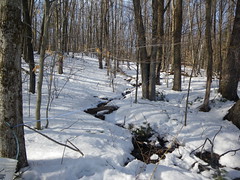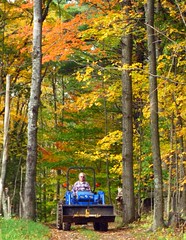I’ve had plenty of time to cogitate, sitting on the tractor in low gear with my heel on the differential lock. This link to Sweet Brook Farm turned my math mind loose. They built a state of the art installation this year to rehab the disused family sugarbush. It couldn’t have cost a penny less than $50k, but even at wholesale prices, they expected to gross $60k. And like everyone with a business head, they want to retail as much as they can, at twice the price.
Anyway, it looks to me like any sugar installation over 100 taps ought to roughly return its capital costs in a year. (Note, this assumes you get the average-good quart per tap that we haven’t managed yet, largely because we don’t get the requisite sap yield.) There’s a lot of fudge factor there about when you build a sugar house, or accounting for the use of chainsaws and vehicles that anyone who owns a sugarbush already has, but it’s a good zeroeth approximation.
However, it also assumes you work for free. Neither the town nor the grocery store are going to let that happen. The real issue is, can you make a living wage and cover, say, 5 year depreciation? (SWAG — expense the gasoline, 20 year depreciation on the building.)
Our 2×4 evaporator will nominally handle 15 gallons per hour. That’s a good average value over a 10 hour day, allowing for heat up and cool down. Let’s say 160 gallons, because at 40/1 that makes 4 gallons, or 16 quarts. At $20 net retail per quart, that’s $320 per day.
Continuing to pull numbers out of the air, I’m going to say that a day of boiling means eight hours of evaporator sitting and four more hours of fetching sap, running tubing and cutting firewood. In turn, calling that 1.5 person days, says that’s a bit over $200/day. Neglecting four hours per day in chores, that extrapolates to $50k/year which is a decent wage. But there’s nothing there for capital costs. I figure our setup, which is about as small and inexpensive as a serious rig can be, costs about $2k plus $3.00 per tap. Tubing and fittings are a lot less, but the sap containers, both in the woods and at the sugar house, turn out to be over $1 per tap.
 Less than 100 taps has no chance of making money, and 250 taps is about the max we can handle with this evaporator. (The Keene Sentinel ran an article last year about a family of four who were doing 300 taps with the same evaporator we have. They had four people, with day jobs, but no animals to feed. 250 it is, for us.) 100 taps is 6 days of boiling, or $2300/6/5 = $80/day, which leaves $240/day or $20/hr. This is just doable with all the overhead we have to cover. However to get that yield you must be tapping yard trees or have a sugarbush that has been pruned for decades to provide enough sun to the sugar trees. Regular forest trees do not give a quart per tap: We didn’t get that much this year even with 122 taps.
Less than 100 taps has no chance of making money, and 250 taps is about the max we can handle with this evaporator. (The Keene Sentinel ran an article last year about a family of four who were doing 300 taps with the same evaporator we have. They had four people, with day jobs, but no animals to feed. 250 it is, for us.) 100 taps is 6 days of boiling, or $2300/6/5 = $80/day, which leaves $240/day or $20/hr. This is just doable with all the overhead we have to cover. However to get that yield you must be tapping yard trees or have a sugarbush that has been pruned for decades to provide enough sun to the sugar trees. Regular forest trees do not give a quart per tap: We didn’t get that much this year even with 122 taps.
At 250 taps, it’s $2750/16 days of boiling/5 year depreciation = $35/day leaving $285/12 or $24/hour. That allows $4*12hrs/day*16 days or $768 to cover the shelter we need to boil that often, and the discount for the trees we have rather than the trees we want. So that’s our goal for next year: have something that resembles a sugar house, and 200 or more taps. We should actually make money.
 The next step is a 50 gallon/hour setup. Now we’re talking $6k plus $3/tap and a full 16 person hours per day of boiling. 500 taps is 5000 gallons or ten days of boiling. 500 quarts is $10k. Depreciation is $6k plus 500 times $3 or $7500. Divided by 10 is $750, divided by 5 years is $150 per day. Ten times 50 gallons of sap is 500 divided by 40 is 12.5 gallons or 50 quarts per day. That’s $1k, less $150 leaves $850. Divided by 16 is $53/hour. That’s a number that works. Further, the same fixed costs will cover 750 taps which should make us seriously profitable.
The next step is a 50 gallon/hour setup. Now we’re talking $6k plus $3/tap and a full 16 person hours per day of boiling. 500 taps is 5000 gallons or ten days of boiling. 500 quarts is $10k. Depreciation is $6k plus 500 times $3 or $7500. Divided by 10 is $750, divided by 5 years is $150 per day. Ten times 50 gallons of sap is 500 divided by 40 is 12.5 gallons or 50 quarts per day. That’s $1k, less $150 leaves $850. Divided by 16 is $53/hour. That’s a number that works. Further, the same fixed costs will cover 750 taps which should make us seriously profitable.
Note, the run can last six weeks, but a month is more normal. I don’t think it’s wise to plan to boil more than half of those days. A couple good days followed by a couple of ok days could have us boiling four days straight, which would leave us seriously juggling the rest of farm and life.
There is a question. We have 250 taps for sure. I’m not sure how many more we have, and how many we can reach on March 1: This is the first year I could get the tractor to the snowmobile trail on March 1. As the snow melted, the mud and water at the second creek rendered it untractorable. Fortunately there was only one bucket past that point, so I carried it out. That, even with snowshoes, is not a general solution. I need to get 800 pounds of sap per hundred taps, per day of good running, out over three feet of snow and later six inches of mud. There’s a lot more than 100 taps past that point. I don’t think the tractor has a prayer. The possibilities I see are either using the horsed to groom a trail for themselves starting with the first snow, or using a snowmobile as long as it will work, then switching to horses. If we’re still around, that’s a big problem for 2013.
I live in Burton , Ohio…maple syrup capital of Ohio! Pancake breakfasts galore at this time of year after hundreds, maybe thousands of buckets have been hanging for weeks. I love it! Your banner is beautiful!